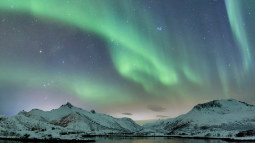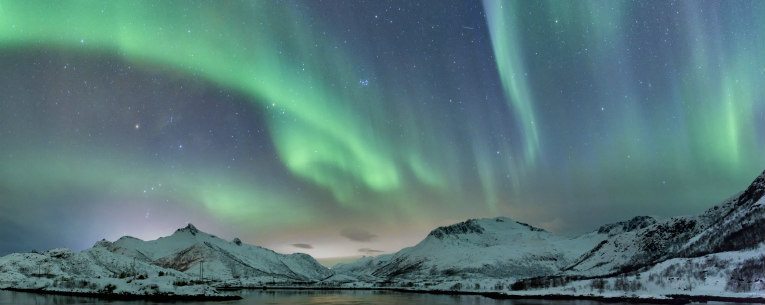Some Inuit believed them to be the spirits of animals they had hunted. The Norse thought they were lights glinting off the armor of the Valkyries, the fabled women warriors. The Finnish people said they were caused by sparks that flew from the tails of foxes running over the tundra.1
Even now that science has explained what causes the northern lights, they’re no less magical. The sight of green, scarlet, yellow, blue and purple bands dancing over the winter sky will take your breath away. Is seeing the aurora borealis on your travel bucket list? Here’s our best advice for when and where to see the northern lights.
What are the northern lights, anyway?
We’re glad you asked, because the answer is so cool. When you look up at the night sky, the space around Earth seems empty and peaceful. The truth is, our planet is constantly being bombarded with solar wind, a stream of plasma and electrically charged particles emitted from the sun. If the solar wind actually hit the surface of the earth, radiation would severely hurt or kill us — but fortunately, we’re shielded by Earth's magnetic field, which deflects the wind. The northern (and southern) lights are what we see toward the poles when solar wind particles strike the atmosphere, releasing energy.2
When’s the best time to see the northern lights?
Timing is essential when you’re scheduling your trip to see the northern lights, which ebb and flow. “Auroras occur most frequently during solar maximum, the most intense phase of the 11-year solar or sunspot cycle,” NASA explains.3 Solar cycle 24, which began in 2008 and saw its peak in 2014, has been the weakest in a century. The next maximum is predicted for 2025.4
But that doesn’t mean you can’t see the northern lights before then! Plan a trip between December and April, when nights are long and skies tend to be clear. You may have to wait a while, as the lights appear every two hours in 30-minute active periods.5
Where is the best place to see the northern lights?
That depends on how far you want to travel from home, as well as how comfortable you want to be. Are you up for camping on the frozen tundra? Or would you rather be sipping Champagne in a hot tub as the aurora swirls overhead? The best places to see the lights are in the auroral oval, a shifting zone centered on the geomagnetic poles. Here are several options for the best place to see the northern lights.
- In Alaska, you can see the lights from Fairbanks, a small city in east-central Alaska. The city lights may obscure the show, however. You can also take an aurora-viewing tour, or stay at the Iniakuk Lake Wilderness Lodge, a luxury retreat 60 miles above the Arctic Circle. The best time to see northern lights in Alaska is from September until about April 20, from about 11:30 p.m. to 3:30 a.m. (this changes depending on the season.)6
- In Canada, the town of Yellowknife calls itself the world’s best place to witness the northern lights. Go from mid-November to April, and head to Aurora Village, an Aboriginal-owned retreat where you can watch from viewing platforms or in heated seats. Other popular places to see the northern lights in Canada include Whitehorse in the Yukon; northern British Columbia; and Churchill in far northern Manitoba, where you may encounter wild polar bears.7
- In Iceland, cloud cover may be an issue, but the upside is that winter temperatures are milder than in other northern-lights destinations. The lights are sometimes visible from the capital, Reykjavik, but the best way to see them is to head north to the Westfjords or north Iceland between September and April.8 Or consider a northern lights tour that includes a little hot-spring soaking!
- In Norway, the northern lights are so prevalent that observers predict the downturn in the solar cycle will do little to dampen the show.9 They’ve made it easy to plan your trip, too, with the free NorthernLights app that predicts aurora activity three days in advance. Popular places to go include the coastal towns of Bodø and Tromsø; or you can go even farther north to the Svalbard islands, where there are more polar bears than people. Svalbard gets no daylight at all from November to February, meaning you can see the lights almost any time.10
- In Sweden, many lights-watchers go to the town of Abisko in Lapland. You can head out on foot, or in a snowmobile-driven sleigh. For an even cooler experience, stay in the famed ICEHOTEL in Jukkasjärvi, a stunning edifice of carved ice. The hotel suggests sleeping in a cold room for the first night, where you’ll snuggle up in a thermal sleeping bag on an ice bed covered in reindeer skins, then warming up with a night in a wooden cabin.
- In Siberia, the best place to see the northern lights is the Kola Peninsula, a rounded piece of land that juts into the sea in northwestern Russia. Fly to the town of Murmansk from Moscow or St. Petersburg, then set off via a snowmobile tour. You might also encounter the semi-nomadic, reindeer-herding indigenous people known as the Sami.11
Other options include cruises to northern Norway, Iceland, Greenland and the Arctic Circle. Wherever you go to see the northern lights, make the most of your chosen destination. Even if you never see the aurora borealis, you can still enjoy wintry fun like dog sledding and cross-country skiing. Don’t forget that when you travel to remote areas, a solid travel insurance plan with emergency medical benefits, such as the OneTrip Prime Plan, is a must. Travel happy (and stay warm)!
Related Articles








Share this Page